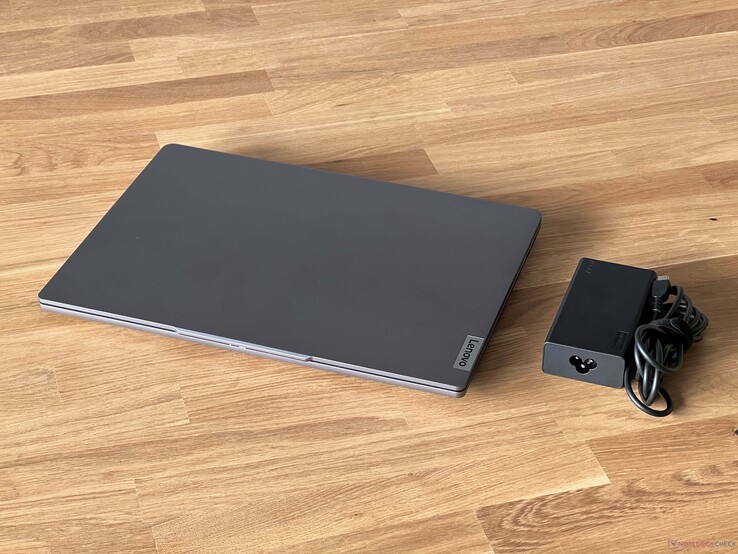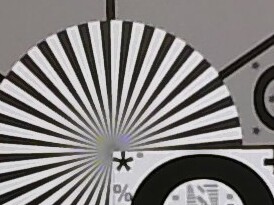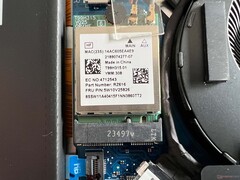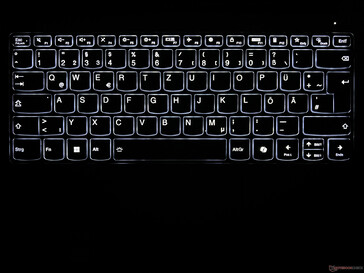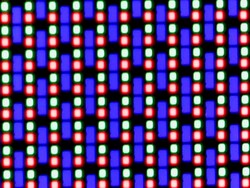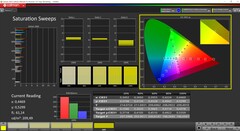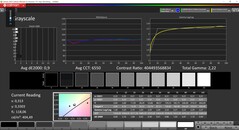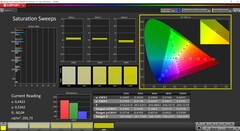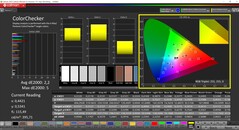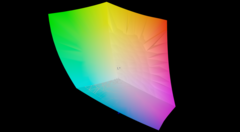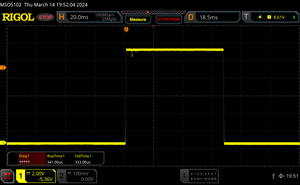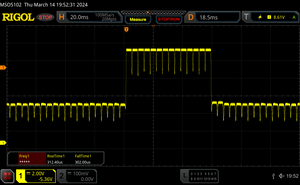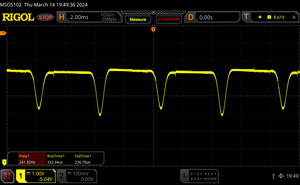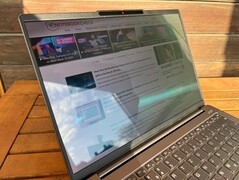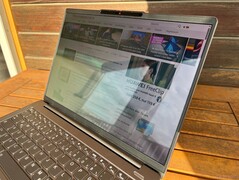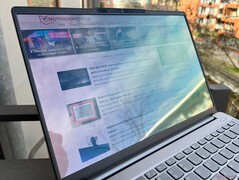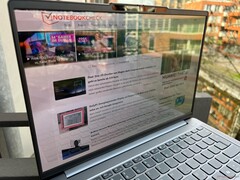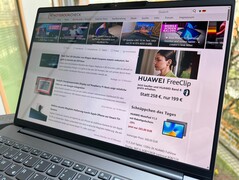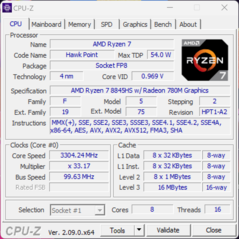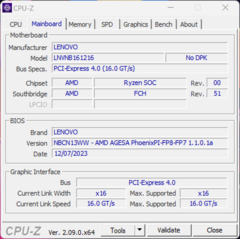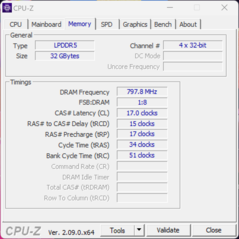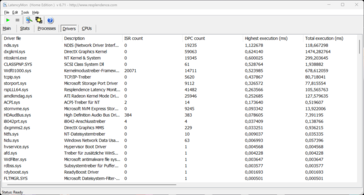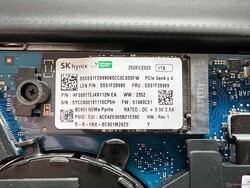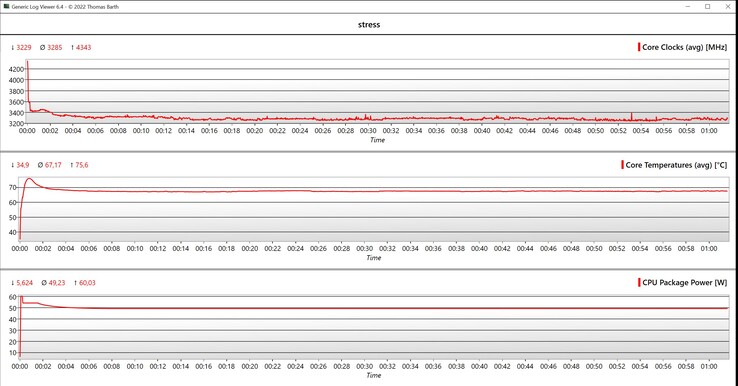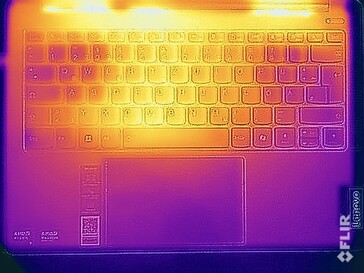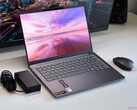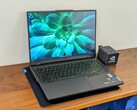Lenovo IdeaPad Pro 5 14AHP9 laptop review - The powerful ultraportable with Ryzen 8000 and 120-Hz OLED

It isn't easy to keep an overview of the current IdeaPad models from Lenovo, as aside from the regular IdeaPad, there is also the IdeaPad Slim and the IdeaPad Pro. We tested the current IdeaPad Slim 5 14 with the Core Ultra 5 125H and a 1080p OLED screen (60 Hz) not that long ago, and now it's time for the more powerful IdeaPad Pro 5 14 G9 featuring the new AMD Ryzen 7 8845HS along with the Radeon 780M and a high-resolution 2.8K OLED panel with a 120-Hz refresh rate.
Our test device with the AMD Ryzen 7 8845HS, 32 GB RAM, a 1-TB SSD and the OLED panel is the Campus variant without an operating system, which can be had for approximately US$1,000. You can get this version (including Windows 11 Home) directly from Lenovo for around US$1,300 and optionally, you can get it with the dedicated GeForce RTX 3050 for about US$200 more. You can also optionally get the device with the new Meteor Lake processors (Core Ultra 5, 7 or 9) from Intel, whereby a comparable configuration with the Core Ultra 7-155H, 32 GB RAM and a 1-TB SSD costs about US$1,500.
Possible competitors compared
Rating | Date | Model | Weight | Height | Size | Resolution | Price |
|---|---|---|---|---|---|---|---|
| 88.1 % v7 (old) | 03 / 2024 | Lenovo IdeaPad Pro 5 14AHP9 R7 8845HS, Radeon 780M | 1.5 kg | 16 mm | 14.00" | 2880x1800 | |
| 88.3 % v7 (old) | 03 / 2024 | Lenovo Yoga Slim 7 14IMH9 Ultra 7 155H, Arc 8-Core | 1.4 kg | 14.9 mm | 14.00" | 1920x1200 | |
| 86.6 % v7 (old) | 03 / 2024 | Lenovo IdeaPad Slim 5 14IMH9 Ultra 5 125H, Arc 7-Core | 1.4 kg | 16.9 mm | 14.00" | 1920x1200 | |
| 87.5 % v7 (old) | 12 / 2023 | HP Pavilion Plus 14-ew0153TU i7-1355U, Iris Xe G7 96EUs | 1.4 kg | 17.5 mm | 14.00" | 2880x1800 | |
| 85.3 % v7 (old) | 06 / 2023 | Asus ZenBook 14 UM3402Y R7 7730U, Vega 8 | 1.4 kg | 16.9 mm | 14.00" | 2880x1800 | |
| 88.5 % v7 (old) | 03 / 2024 | Lenovo Yoga Pro 7 14IMH9 Ultra 7 155H, Arc 8-Core | 1.6 kg | 16.6 mm | 14.50" | 3072x1920 |
Case - The IdeaPad 5 clad in aluminum
In everyday use, its silver aluminum case doesn't stand out too much and aside from its dark-gray keyboard and stickers on the wrist rest, there are no contrasting colors. As a result, the IdeaPad can be easily used in private as well as professional surroundings. Its bezels are nice and slim but there is a notch in which the camera lies. This does make it super easy to open the display lid, however, it doesn't look particularly good. Its smooth surfaces don't attract all too many fingerprint marks.
In general, the aluminum case appears high-quality—at least at first glance. You can visibly depress the keyboard area, which also leads to some subtle creaking noises. In this aspect, you can notice a slight difference compared to the Yoga Pro models. Its lid, on the other hand, is more of a success and its hinges have been adjusted well; opening it with one hand is no problem and it practically doesn't wobble at all when adjusting the angle. Its maximum opening angle is 180 degrees.
Within our comparison group, the IdeaPad Pro 5 14 is one of the most compact devices and its weight of about 1.5 kg is average. There are considerably lighter 14-inch laptops on the market but even so, you can pack the IdeaPad into most bags without an issue so you can take it with you on your travels.
Connectivity - The AMD IdeaPad with USB 4.0
Although the IdeaPad Pro series doesn't consist of Lenovo's high-end models, buyers don't have to worry about the device's connectivity standards. Aside from USB 4.0, you also have access to an HDMI 2.1 output and two regular USB-A ports on the right.
SD card reader
The right side of the laptop houses a full-featured SD card reader that, in combination with our reference card (Angelbird AV Pro V60), achieved decent transfer rates of 75-90 MB/s. Inserted cards stick out of the case by about 1.8 cm.
| SD Card Reader | |
| average JPG Copy Test (av. of 3 runs) | |
| Lenovo IdeaPad Slim 5 14IMH9 (AV PRO microSD 128 GB V60) | |
| Lenovo IdeaPad Pro 5 14AHP9 (Angelbird AV Pro V60) | |
| Asus ZenBook 14 UM3402Y (AV PRO microSD 128 GB V60) | |
| Average of class Subnotebook (18.4 - 142, n=13, last 2 years) | |
| maximum AS SSD Seq Read Test (1GB) | |
| Asus ZenBook 14 UM3402Y (AV PRO microSD 128 GB V60) | |
| Lenovo IdeaPad Slim 5 14IMH9 (AV PRO microSD 128 GB V60) | |
| Lenovo IdeaPad Pro 5 14AHP9 (Angelbird AV Pro V60) | |
| Average of class Subnotebook (22.5 - 207, n=13, last 2 years) | |
Communication
Lenovo uses a WLAN module from MediaTek (RZ616) which also supports the WiFi-6E standard with 6-GHz networks. In combination with our reference router from Asus, its transfer rates were very high and stable, however, we didn't determine there to be a performance advantage when using the 6-GHz network. During the test, its signal quality was also very good with other routers.
| Networking | |
| Lenovo IdeaPad Pro 5 14AHP9 | |
| iperf3 transmit AXE11000 | |
| iperf3 receive AXE11000 | |
| Lenovo Yoga Slim 7 14IMH9 | |
| iperf3 transmit AXE11000 | |
| iperf3 receive AXE11000 | |
| iperf3 transmit AXE11000 6GHz | |
| iperf3 receive AXE11000 6GHz | |
| Lenovo IdeaPad Slim 5 14IMH9 | |
| iperf3 transmit AXE11000 | |
| iperf3 receive AXE11000 | |
| HP Pavilion Plus 14-ew0153TU | |
| iperf3 transmit AXE11000 | |
| iperf3 receive AXE11000 | |
| iperf3 transmit AXE11000 6GHz | |
| iperf3 receive AXE11000 6GHz | |
| Asus ZenBook 14 UM3402Y | |
| iperf3 transmit AXE11000 | |
| iperf3 receive AXE11000 | |
| iperf3 transmit AXE11000 6GHz | |
| iperf3 receive AXE11000 6GHz | |
| Lenovo Yoga Pro 7 14IMH9 | |
| iperf3 transmit AXE11000 | |
| iperf3 receive AXE11000 | |
Webcam
Lenovo has installed a 1080p camera with a mechanical cover, however, its picture quality isn't the best. The same as on the current Meteor Lake models, the AMD IdeaPad, too, supports webcam studio effects (background soft focus, eye contact, tracking) as part of the operating system. In addition, it features an IR camera for facial recognition via Windows Hello.
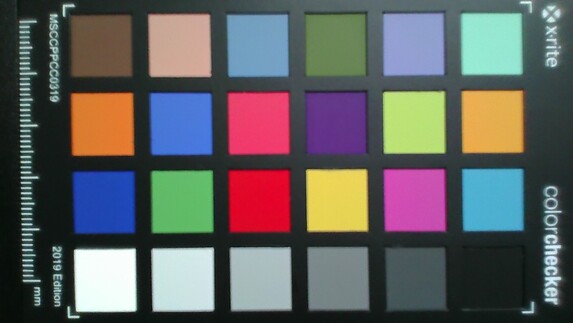
Maintenance
In addition to six Torx screws, the bottom case cover is secured with a number of plastic clips and you have to be careful not to damage them when removing it. Inside, the fans can be cleaned and both the WLAN module and the M.2-2242 SSD can be replaced. The battery is screwed in and can be replaced if necessary.
Input devices - The IdeaPad with wobbly keys
One further discipline in which the IdeaPad trails behind its more expensive siblings is its keyboard. Although its dark-gray keys offer enough lift and comfortable feedback, the keyboard in general feels a little rickety and, as a result, comparatively loud. There is now a dedicated key for Windows Co-Pilot and the power button is on the right above the keyboard. It features white backlighting with two brightness levels.
Its 12 x 7.5 cm clickpad is large enough and sits slightly lowered within the base unit, letting you feel for it super easily. It is nice and smooth and we never had any issues operating it during our test, however, its mechanical clicks sound quite loud.
Display - 120-Hz OLED
Lenovo has equipped all variants of the IdeaPad Pro 5 14 with a 14-inch OLED screen. In contrast to the Full HD model of the IdeaPad Slim 5, its resolution and frequency are higher, namely 2,880 x 1,800 pixels and 120 Hz respectively. Subjectively, its picture quality is astounding, especially when comparing it to the IdeaPad Pro 5 16's IPS panel. Colors are vivid, black is truly black and its response times are super quick. It doesn't feature a brightness sensor.
Lenovo has indicated a brightness of 400 cd/m² in SDR use and up to 600 cd/m² in HDR use, which we were able to confirm. Its average SDR brightness is about 414 cd/m² and thanks to its low black value, its contrast ratio is extremely high. These values correspond to the current OLED standard, so this screen's picture quality is practically identical. This does, unfortunately, include the PWM flickering at 240 Hz (at 99 % brightness or lower). We measured a maximum HDR brightness of 601 cd/m² when depicting image excerpts and around 500 cd/m² when depicting an almost entirely white screen.
| |||||||||||||||||||||||||
Brightness Distribution: 99 %
Center on Battery: 411 cd/m²
Contrast: ∞:1 (Black: 0 cd/m²)
ΔE ColorChecker Calman: 2.8 | ∀{0.5-29.43 Ø4.78}
calibrated: 2.2
ΔE Greyscale Calman: 1.8 | ∀{0.09-98 Ø5}
98.9% AdobeRGB 1998 (Argyll 3D)
100% sRGB (Argyll 3D)
99.9% Display P3 (Argyll 3D)
Gamma: 2.21
CCT: 6319 K
| Lenovo IdeaPad Pro 5 14AHP9 LEN140WQ+, OLED, 2880x1800, 14" | Lenovo Yoga Slim 7 14IMH9 LEN140WUXGA, OLED, 1920x1200, 14" | Lenovo IdeaPad Slim 5 14IMH9 LENOVO LEN140WUXGA (LEN88AC), OLED, 1920x1200, 14" | HP Pavilion Plus 14-ew0153TU Samsung SDC4197, OLED, 2880x1800, 14" | Asus ZenBook 14 UM3402Y Samsung ATNA40YK07-1, OLED, 2880x1800, 14" | Lenovo Yoga Pro 7 14IMH9 Lenovo LEN145-3K (LEN8AAF), IPS, 3072x1920, 14.5" | |
|---|---|---|---|---|---|---|
| Display | -1% | -1% | -3% | -0% | -5% | |
| Display P3 Coverage (%) | 99.9 | 99.8 0% | 99.9 0% | 97.9 -2% | 99.9 0% | 98.4 -2% |
| sRGB Coverage (%) | 100 | 100 0% | 100 0% | 99.6 0% | 100 0% | 100 0% |
| AdobeRGB 1998 Coverage (%) | 98.9 | 97.3 -2% | 96.7 -2% | 92.1 -7% | 98.3 -1% | 86.9 -12% |
| Response Times | -218% | -96% | -1479% | -119% | -3770% | |
| Response Time Grey 50% / Grey 80% * (ms) | 0.61 ? | 1.78 ? -192% | 1.3 ? -113% | 10.8 ? -1670% | 1.19 ? -95% | 34.1 ? -5490% |
| Response Time Black / White * (ms) | 0.67 ? | 2.3 ? -243% | 1.2 ? -79% | 9.29 ? -1287% | 1.62 ? -142% | 14.4 ? -2049% |
| PWM Frequency (Hz) | 240 ? | 489.7 ? | 240 | 120 ? | 362.3 ? | |
| Screen | -2% | 10% | 6% | 17% | 35% | |
| Brightness middle (cd/m²) | 411 | 388.3 -6% | 392 -5% | 387 -6% | 336.6 -18% | 464 13% |
| Brightness (cd/m²) | 414 | 388 -6% | 388 -6% | 387 -7% | 339 -18% | 456 10% |
| Brightness Distribution (%) | 99 | 97 -2% | 97 -2% | 97 -2% | 98 -1% | 90 -9% |
| Black Level * (cd/m²) | 0.02 | 0.01 | 0.36 | |||
| Colorchecker dE 2000 * | 2.8 | 4.4 -57% | 1.75 37% | 2.03 27% | 0.84 70% | 0.9 68% |
| Colorchecker dE 2000 max. * | 5.5 | 7.37 -34% | 4.46 19% | 3.86 30% | 3.1 44% | 2.32 58% |
| Colorchecker dE 2000 calibrated * | 2.2 | 0.64 71% | 1.59 28% | 1.6 27% | 0.35 84% | |
| Greyscale dE 2000 * | 1.8 | 1.4 22% | 1.8 -0% | 2.3 -28% | 1.4 22% | 1.4 22% |
| Gamma | 2.21 100% | 2.24 98% | 2.249 98% | 2.23 99% | 2.24 98% | 2.218 99% |
| CCT | 6319 103% | 6339 103% | 6574 99% | 6523 100% | 6439 101% | 6669 97% |
| Contrast (:1) | 19600 | 38700 | 1289 | |||
| Total Average (Program / Settings) | -74% /
-37% | -29% /
-10% | -492% /
-244% | -34% /
-13% | -1247% /
-609% |
* ... smaller is better
Lenovo doesn't offer any color profiles, meaning its color space is limited to the smaller sRGB reference. In our analysis using the professional CalMAN software (X-Rite i1 Pro 2), the test device showed decent performance straight out of the box, even if its color temperature was a tiny bit too warm. Even so, quite a few color deviations were above 3 and even after calibrating it ourselves (profile can be downloaded for free above), they could be improved but not gotten rid of.
Display Response Times
| ↔ Response Time Black to White | ||
|---|---|---|
| 0.67 ms ... rise ↗ and fall ↘ combined | ↗ 0.34 ms rise | |
| ↘ 0.33 ms fall | ||
| The screen shows very fast response rates in our tests and should be very well suited for fast-paced gaming. In comparison, all tested devices range from 0.1 (minimum) to 240 (maximum) ms. » 1 % of all devices are better. This means that the measured response time is better than the average of all tested devices (20.2 ms). | ||
| ↔ Response Time 50% Grey to 80% Grey | ||
| 0.61 ms ... rise ↗ and fall ↘ combined | ↗ 0.31 ms rise | |
| ↘ 0.3 ms fall | ||
| The screen shows very fast response rates in our tests and should be very well suited for fast-paced gaming. In comparison, all tested devices range from 0.165 (minimum) to 636 (maximum) ms. » 1 % of all devices are better. This means that the measured response time is better than the average of all tested devices (31.6 ms). | ||
Screen Flickering / PWM (Pulse-Width Modulation)
| Screen flickering / PWM detected | 240 Hz | ≤ 99 % brightness setting | |
The display backlight flickers at 240 Hz (worst case, e.g., utilizing PWM) Flickering detected at a brightness setting of 99 % and below. There should be no flickering or PWM above this brightness setting. The frequency of 240 Hz is relatively low, so sensitive users will likely notice flickering and experience eyestrain at the stated brightness setting and below. In comparison: 53 % of all tested devices do not use PWM to dim the display. If PWM was detected, an average of 8091 (minimum: 5 - maximum: 343500) Hz was measured. | |||
Although this isn't a touchscreen, the OLED panel is still quite reflective, which limits its use in outdoor spaces. Even indoors, reflections can quickly turn into an issue. Aside from a slight blue shimmer, there are no limitations when it comes to the screen's viewing-angle stability.
Performance - AMD Zen4 and 32 GB RAM
Testing conditions
Lenovo offers three different energy profiles: battery-saving mode, smart cooling & maximum performance—we have listed the respective performance values in the table below. We ran the benchmarks and measured values using the default intelligent cooling mode, but we would have liked to see a wider spread compared to maximum performance mode.
| Energy profile | CPU TDP | CB R23 Multi | Time Spy Graphics | Cyberpunk 2077 1080p Low | max. fan noise emissions |
|---|---|---|---|---|---|
| Battery-saving mode | 33 -> 25 watts | 12,121 points | 2,647 points | 39.8fps | 31.5 dB(A) |
| Intelligent cooling | 60 -> 50 watts | 15,889 points | 2,847 points | 42.4fps | 44.3 dB(A) |
| Maximum performance | 65 -> 60 watts | 16,389 points | 2,818 points | 42.8fps | 46.6 dB(A) |
Processor - Ryzen 7 8845HS
The AMD Ryzen 7 8845HS belongs to the current Ryzen 8000 generation and makes use of 8 Zen4 cores (16 threads) which can reach a maximum of 5.1 GHz. This is the direct competitor to the Core Ultra 7 155H within the Yoga Pro 7, where the Intel chip is allowed to consume slightly more power, namely 64/55 watts. Still, the AMD processor came just ahead of the 155H in the benchmarks, with its performance remaining nearly constant even under longer periods of load—and the same could be said in battery mode. The IdeaPad Pro 5 with its Intel CPUs should also deliver very good results, however, with a price difference of only US$200, it makes way more sense to go for the AMD CPU. Further benchmarks can be found in our tech section.
Cinebench R15 Multi continuous test
Cinebench R23: Multi Core | Single Core
Cinebench R20: CPU (Multi Core) | CPU (Single Core)
Cinebench R15: CPU Multi 64Bit | CPU Single 64Bit
Blender: v2.79 BMW27 CPU
7-Zip 18.03: 7z b 4 | 7z b 4 -mmt1
Geekbench 6.5: Multi-Core | Single-Core
Geekbench 5.5: Multi-Core | Single-Core
HWBOT x265 Benchmark v2.2: 4k Preset
LibreOffice : 20 Documents To PDF
R Benchmark 2.5: Overall mean
| CPU Performance rating | |
| Average AMD Ryzen 7 8845HS | |
| Lenovo IdeaPad Pro 5 14AHP9 | |
| Lenovo Yoga Pro 7 14IMH9 | |
| Lenovo Yoga Slim 7 14IMH9 | |
| Average of class Subnotebook | |
| Lenovo IdeaPad Slim 5 14IMH9 -1! | |
| Asus ZenBook 14 UM3402Y -3! | |
| HP Pavilion Plus 14-ew0153TU | |
| Cinebench R23 / Multi Core | |
| Average AMD Ryzen 7 8845HS (14895 - 18037, n=13) | |
| Lenovo IdeaPad Pro 5 14AHP9 | |
| Lenovo Yoga Pro 7 14IMH9 | |
| Lenovo Yoga Slim 7 14IMH9 | |
| Lenovo IdeaPad Slim 5 14IMH9 | |
| Average of class Subnotebook (1555 - 21812, n=73, last 2 years) | |
| Asus ZenBook 14 UM3402Y | |
| HP Pavilion Plus 14-ew0153TU | |
| Cinebench R23 / Single Core | |
| Average AMD Ryzen 7 8845HS (1623 - 1783, n=13) | |
| HP Pavilion Plus 14-ew0153TU | |
| Lenovo IdeaPad Pro 5 14AHP9 | |
| Average of class Subnotebook (358 - 2165, n=74, last 2 years) | |
| Lenovo Yoga Slim 7 14IMH9 | |
| Lenovo IdeaPad Slim 5 14IMH9 | |
| Lenovo Yoga Pro 7 14IMH9 | |
| Asus ZenBook 14 UM3402Y | |
| Cinebench R20 / CPU (Multi Core) | |
| Average AMD Ryzen 7 8845HS (5808 - 7026, n=13) | |
| Lenovo IdeaPad Pro 5 14AHP9 | |
| Lenovo Yoga Slim 7 14IMH9 | |
| Lenovo Yoga Pro 7 14IMH9 | |
| Lenovo IdeaPad Slim 5 14IMH9 | |
| Average of class Subnotebook (579 - 8541, n=68, last 2 years) | |
| Asus ZenBook 14 UM3402Y | |
| HP Pavilion Plus 14-ew0153TU | |
| Cinebench R20 / CPU (Single Core) | |
| Average AMD Ryzen 7 8845HS (673 - 698, n=13) | |
| Lenovo IdeaPad Pro 5 14AHP9 | |
| Lenovo Yoga Pro 7 14IMH9 | |
| Lenovo Yoga Slim 7 14IMH9 | |
| HP Pavilion Plus 14-ew0153TU | |
| Average of class Subnotebook (128 - 826, n=68, last 2 years) | |
| Lenovo IdeaPad Slim 5 14IMH9 | |
| Asus ZenBook 14 UM3402Y | |
| Cinebench R15 / CPU Multi 64Bit | |
| Average AMD Ryzen 7 8845HS (2342 - 2908, n=13) | |
| Lenovo IdeaPad Pro 5 14AHP9 | |
| Lenovo Yoga Pro 7 14IMH9 | |
| Lenovo Yoga Slim 7 14IMH9 | |
| Lenovo IdeaPad Slim 5 14IMH9 | |
| Average of class Subnotebook (327 - 3345, n=68, last 2 years) | |
| Asus ZenBook 14 UM3402Y | |
| HP Pavilion Plus 14-ew0153TU | |
| Cinebench R15 / CPU Single 64Bit | |
| Average AMD Ryzen 7 8845HS (269 - 283, n=13) | |
| Lenovo IdeaPad Pro 5 14AHP9 | |
| Lenovo Yoga Pro 7 14IMH9 | |
| Average of class Subnotebook (72.4 - 322, n=68, last 2 years) | |
| Lenovo Yoga Slim 7 14IMH9 | |
| HP Pavilion Plus 14-ew0153TU | |
| Lenovo IdeaPad Slim 5 14IMH9 | |
| Asus ZenBook 14 UM3402Y | |
| Blender / v2.79 BMW27 CPU | |
| HP Pavilion Plus 14-ew0153TU | |
| Average of class Subnotebook (159 - 2271, n=71, last 2 years) | |
| Lenovo IdeaPad Slim 5 14IMH9 | |
| Lenovo Yoga Slim 7 14IMH9 | |
| Lenovo IdeaPad Pro 5 14AHP9 | |
| Lenovo Yoga Pro 7 14IMH9 | |
| Average AMD Ryzen 7 8845HS (179 - 216, n=13) | |
| 7-Zip 18.03 / 7z b 4 | |
| Average AMD Ryzen 7 8845HS (62669 - 74664, n=13) | |
| Lenovo IdeaPad Pro 5 14AHP9 | |
| Lenovo Yoga Pro 7 14IMH9 | |
| Lenovo Yoga Slim 7 14IMH9 | |
| Asus ZenBook 14 UM3402Y | |
| Average of class Subnotebook (11668 - 77867, n=68, last 2 years) | |
| HP Pavilion Plus 14-ew0153TU | |
| 7-Zip 18.03 / 7z b 4 -mmt1 | |
| Average AMD Ryzen 7 8845HS (5197 - 6714, n=13) | |
| Lenovo IdeaPad Pro 5 14AHP9 | |
| HP Pavilion Plus 14-ew0153TU | |
| Average of class Subnotebook (2643 - 6442, n=70, last 2 years) | |
| Lenovo Yoga Pro 7 14IMH9 | |
| Asus ZenBook 14 UM3402Y | |
| Lenovo Yoga Slim 7 14IMH9 | |
| Lenovo IdeaPad Slim 5 14IMH9 | |
| Geekbench 6.5 / Multi-Core | |
| Lenovo Yoga Pro 7 14IMH9 | |
| Average AMD Ryzen 7 8845HS (11073 - 14014, n=18) | |
| Lenovo IdeaPad Pro 5 14AHP9 | |
| Average of class Subnotebook (2244 - 17489, n=79, last 2 years) | |
| Lenovo Yoga Slim 7 14IMH9 | |
| Lenovo IdeaPad Slim 5 14IMH9 | |
| HP Pavilion Plus 14-ew0153TU | |
| Geekbench 6.5 / Single-Core | |
| Average of class Subnotebook (960 - 3820, n=73, last 2 years) | |
| Average AMD Ryzen 7 8845HS (2510 - 2698, n=16) | |
| HP Pavilion Plus 14-ew0153TU | |
| Lenovo IdeaPad Pro 5 14AHP9 | |
| Lenovo Yoga Pro 7 14IMH9 | |
| Lenovo Yoga Slim 7 14IMH9 | |
| Lenovo IdeaPad Slim 5 14IMH9 | |
| Geekbench 5.5 / Multi-Core | |
| Lenovo Yoga Pro 7 14IMH9 | |
| Average AMD Ryzen 7 8845HS (11256 - 12726, n=15) | |
| Lenovo IdeaPad Pro 5 14AHP9 | |
| Lenovo Yoga Slim 7 14IMH9 | |
| Lenovo IdeaPad Slim 5 14IMH9 | |
| Average of class Subnotebook (2557 - 17218, n=63, last 2 years) | |
| Asus ZenBook 14 UM3402Y | |
| HP Pavilion Plus 14-ew0153TU | |
| Geekbench 5.5 / Single-Core | |
| Average AMD Ryzen 7 8845HS (1765 - 2004, n=15) | |
| Average of class Subnotebook (726 - 2350, n=63, last 2 years) | |
| Lenovo IdeaPad Pro 5 14AHP9 | |
| HP Pavilion Plus 14-ew0153TU | |
| Lenovo Yoga Slim 7 14IMH9 | |
| Lenovo Yoga Pro 7 14IMH9 | |
| Lenovo IdeaPad Slim 5 14IMH9 | |
| Asus ZenBook 14 UM3402Y | |
| HWBOT x265 Benchmark v2.2 / 4k Preset | |
| Average AMD Ryzen 7 8845HS (18.6 - 22.7, n=13) | |
| Lenovo IdeaPad Pro 5 14AHP9 | |
| Lenovo Yoga Pro 7 14IMH9 | |
| Lenovo Yoga Slim 7 14IMH9 | |
| Lenovo IdeaPad Slim 5 14IMH9 | |
| Asus ZenBook 14 UM3402Y | |
| Average of class Subnotebook (0.97 - 25.1, n=68, last 2 years) | |
| HP Pavilion Plus 14-ew0153TU | |
| LibreOffice / 20 Documents To PDF | |
| Lenovo Yoga Pro 7 14IMH9 | |
| Lenovo IdeaPad Slim 5 14IMH9 | |
| HP Pavilion Plus 14-ew0153TU | |
| Average of class Subnotebook (38.5 - 220, n=67, last 2 years) | |
| Asus ZenBook 14 UM3402Y | |
| Average AMD Ryzen 7 8845HS (44.4 - 77, n=13) | |
| Lenovo IdeaPad Pro 5 14AHP9 | |
| Lenovo Yoga Slim 7 14IMH9 | |
| R Benchmark 2.5 / Overall mean | |
| Asus ZenBook 14 UM3402Y | |
| Lenovo IdeaPad Slim 5 14IMH9 | |
| Average of class Subnotebook (0.403 - 1.456, n=69, last 2 years) | |
| Lenovo Yoga Pro 7 14IMH9 | |
| Lenovo Yoga Slim 7 14IMH9 | |
| HP Pavilion Plus 14-ew0153TU | |
| Average AMD Ryzen 7 8845HS (0.4304 - 0.4935, n=13) | |
| Lenovo IdeaPad Pro 5 14AHP9 | |
* ... smaller is better
AIDA64: FP32 Ray-Trace | FPU Julia | CPU SHA3 | CPU Queen | FPU SinJulia | FPU Mandel | CPU AES | CPU ZLib | FP64 Ray-Trace | CPU PhotoWorxx
| Performance rating | |
| Average AMD Ryzen 7 8845HS | |
| Lenovo IdeaPad Pro 5 14AHP9 | |
| Lenovo Yoga Pro 7 14IMH9 | |
| Lenovo Yoga Slim 7 14IMH9 | |
| Asus ZenBook 14 UM3402Y | |
| Average of class Subnotebook | |
| Lenovo IdeaPad Slim 5 14IMH9 | |
| HP Pavilion Plus 14-ew0153TU | |
| AIDA64 / FP32 Ray-Trace | |
| Lenovo IdeaPad Pro 5 14AHP9 | |
| Average AMD Ryzen 7 8845HS (23708 - 29544, n=13) | |
| Lenovo Yoga Pro 7 14IMH9 | |
| Average of class Subnotebook (1135 - 32888, n=67, last 2 years) | |
| Lenovo Yoga Slim 7 14IMH9 | |
| Asus ZenBook 14 UM3402Y | |
| Lenovo IdeaPad Slim 5 14IMH9 | |
| HP Pavilion Plus 14-ew0153TU | |
| AIDA64 / FPU Julia | |
| Lenovo IdeaPad Pro 5 14AHP9 | |
| Average AMD Ryzen 7 8845HS (99659 - 125873, n=13) | |
| Lenovo Yoga Pro 7 14IMH9 | |
| Asus ZenBook 14 UM3402Y | |
| Lenovo Yoga Slim 7 14IMH9 | |
| Average of class Subnotebook (5218 - 123315, n=67, last 2 years) | |
| Lenovo IdeaPad Slim 5 14IMH9 | |
| HP Pavilion Plus 14-ew0153TU | |
| AIDA64 / CPU SHA3 | |
| Average AMD Ryzen 7 8845HS (4332 - 5180, n=13) | |
| Lenovo IdeaPad Pro 5 14AHP9 | |
| Lenovo Yoga Pro 7 14IMH9 | |
| Lenovo Yoga Slim 7 14IMH9 | |
| Average of class Subnotebook (444 - 5287, n=67, last 2 years) | |
| Asus ZenBook 14 UM3402Y | |
| Lenovo IdeaPad Slim 5 14IMH9 | |
| HP Pavilion Plus 14-ew0153TU | |
| AIDA64 / CPU Queen | |
| Average AMD Ryzen 7 8845HS (109458 - 124695, n=13) | |
| Lenovo IdeaPad Pro 5 14AHP9 | |
| Asus ZenBook 14 UM3402Y | |
| Lenovo Yoga Pro 7 14IMH9 | |
| Lenovo IdeaPad Slim 5 14IMH9 | |
| Lenovo Yoga Slim 7 14IMH9 | |
| Average of class Subnotebook (10579 - 115682, n=67, last 2 years) | |
| HP Pavilion Plus 14-ew0153TU | |
| AIDA64 / FPU SinJulia | |
| Lenovo IdeaPad Pro 5 14AHP9 | |
| Average AMD Ryzen 7 8845HS (14062 - 15519, n=13) | |
| Asus ZenBook 14 UM3402Y | |
| Lenovo Yoga Pro 7 14IMH9 | |
| Lenovo Yoga Slim 7 14IMH9 | |
| Lenovo IdeaPad Slim 5 14IMH9 | |
| Average of class Subnotebook (744 - 18418, n=67, last 2 years) | |
| HP Pavilion Plus 14-ew0153TU | |
| AIDA64 / FPU Mandel | |
| Lenovo IdeaPad Pro 5 14AHP9 | |
| Average AMD Ryzen 7 8845HS (53436 - 67367, n=13) | |
| Asus ZenBook 14 UM3402Y | |
| Lenovo Yoga Pro 7 14IMH9 | |
| Lenovo Yoga Slim 7 14IMH9 | |
| Average of class Subnotebook (3341 - 65433, n=67, last 2 years) | |
| Lenovo IdeaPad Slim 5 14IMH9 | |
| HP Pavilion Plus 14-ew0153TU | |
| AIDA64 / CPU AES | |
| Average AMD Ryzen 7 8845HS (64515 - 172642, n=13) | |
| Lenovo Yoga Pro 7 14IMH9 | |
| Lenovo Yoga Slim 7 14IMH9 | |
| Lenovo IdeaPad Pro 5 14AHP9 | |
| Lenovo IdeaPad Slim 5 14IMH9 | |
| Average of class Subnotebook (638 - 161430, n=67, last 2 years) | |
| Asus ZenBook 14 UM3402Y | |
| HP Pavilion Plus 14-ew0153TU | |
| AIDA64 / CPU ZLib | |
| Lenovo Yoga Pro 7 14IMH9 | |
| Average AMD Ryzen 7 8845HS (627 - 1080, n=13) | |
| Lenovo Yoga Slim 7 14IMH9 | |
| Lenovo IdeaPad Slim 5 14IMH9 | |
| Average of class Subnotebook (164.9 - 1379, n=67, last 2 years) | |
| Asus ZenBook 14 UM3402Y | |
| Lenovo IdeaPad Pro 5 14AHP9 | |
| HP Pavilion Plus 14-ew0153TU | |
| AIDA64 / FP64 Ray-Trace | |
| Lenovo IdeaPad Pro 5 14AHP9 | |
| Average AMD Ryzen 7 8845HS (12361 - 15911, n=13) | |
| Lenovo Yoga Pro 7 14IMH9 | |
| Average of class Subnotebook (610 - 17495, n=67, last 2 years) | |
| Lenovo Yoga Slim 7 14IMH9 | |
| Asus ZenBook 14 UM3402Y | |
| Lenovo IdeaPad Slim 5 14IMH9 | |
| HP Pavilion Plus 14-ew0153TU | |
| AIDA64 / CPU PhotoWorxx | |
| Lenovo Yoga Slim 7 14IMH9 | |
| Lenovo Yoga Pro 7 14IMH9 | |
| Lenovo IdeaPad Slim 5 14IMH9 | |
| Average of class Subnotebook (6569 - 64588, n=67, last 2 years) | |
| Average AMD Ryzen 7 8845HS (33192 - 41668, n=13) | |
| Lenovo IdeaPad Pro 5 14AHP9 | |
| HP Pavilion Plus 14-ew0153TU | |
| Asus ZenBook 14 UM3402Y | |
System performance
The IdeaPad Pro left an excellent impression both in the synthetic benchmarks and in everyday use, and we did not notice any problems with the system's stability during our test.
CrossMark: Overall | Productivity | Creativity | Responsiveness
WebXPRT 3: Overall
WebXPRT 4: Overall
Mozilla Kraken 1.1: Total
| PCMark 10 / Score | |
| Average AMD Ryzen 7 8845HS, AMD Radeon 780M (6993 - 7641, n=8) | |
| Lenovo IdeaPad Pro 5 14AHP9 | |
| Average of class Subnotebook (4920 - 8424, n=55, last 2 years) | |
| Lenovo Yoga Pro 7 14IMH9 | |
| Lenovo Yoga Slim 7 14IMH9 | |
| Lenovo IdeaPad Slim 5 14IMH9 | |
| Asus ZenBook 14 UM3402Y | |
| HP Pavilion Plus 14-ew0153TU | |
| PCMark 10 / Essentials | |
| Average AMD Ryzen 7 8845HS, AMD Radeon 780M (10286 - 11570, n=8) | |
| Lenovo Yoga Slim 7 14IMH9 | |
| Lenovo IdeaPad Pro 5 14AHP9 | |
| Lenovo Yoga Pro 7 14IMH9 | |
| Asus ZenBook 14 UM3402Y | |
| Average of class Subnotebook (8552 - 11406, n=55, last 2 years) | |
| HP Pavilion Plus 14-ew0153TU | |
| Lenovo IdeaPad Slim 5 14IMH9 | |
| PCMark 10 / Productivity | |
| Average AMD Ryzen 7 8845HS, AMD Radeon 780M (9742 - 10482, n=8) | |
| Lenovo IdeaPad Pro 5 14AHP9 | |
| Asus ZenBook 14 UM3402Y | |
| Average of class Subnotebook (5435 - 16132, n=55, last 2 years) | |
| Lenovo Yoga Slim 7 14IMH9 | |
| Lenovo Yoga Pro 7 14IMH9 | |
| Lenovo IdeaPad Slim 5 14IMH9 | |
| HP Pavilion Plus 14-ew0153TU | |
| PCMark 10 / Digital Content Creation | |
| Lenovo Yoga Pro 7 14IMH9 | |
| Average AMD Ryzen 7 8845HS, AMD Radeon 780M (9009 - 10009, n=8) | |
| Lenovo IdeaPad Pro 5 14AHP9 | |
| Average of class Subnotebook (5722 - 12442, n=55, last 2 years) | |
| Lenovo Yoga Slim 7 14IMH9 | |
| Lenovo IdeaPad Slim 5 14IMH9 | |
| HP Pavilion Plus 14-ew0153TU | |
| Asus ZenBook 14 UM3402Y | |
| CrossMark / Overall | |
| Lenovo IdeaPad Pro 5 14AHP9 | |
| Average AMD Ryzen 7 8845HS, AMD Radeon 780M (1633 - 1939, n=8) | |
| Lenovo Yoga Slim 7 14IMH9 | |
| Average of class Subnotebook (365 - 2038, n=68, last 2 years) | |
| HP Pavilion Plus 14-ew0153TU | |
| Asus ZenBook 14 UM3402Y | |
| CrossMark / Productivity | |
| Lenovo IdeaPad Pro 5 14AHP9 | |
| Average AMD Ryzen 7 8845HS, AMD Radeon 780M (1562 - 1872, n=8) | |
| Lenovo Yoga Slim 7 14IMH9 | |
| HP Pavilion Plus 14-ew0153TU | |
| Average of class Subnotebook (364 - 1918, n=68, last 2 years) | |
| Asus ZenBook 14 UM3402Y | |
| CrossMark / Creativity | |
| Lenovo IdeaPad Pro 5 14AHP9 | |
| Average AMD Ryzen 7 8845HS, AMD Radeon 780M (1734 - 2052, n=8) | |
| Lenovo Yoga Slim 7 14IMH9 | |
| Average of class Subnotebook (372 - 2396, n=68, last 2 years) | |
| HP Pavilion Plus 14-ew0153TU | |
| Asus ZenBook 14 UM3402Y | |
| CrossMark / Responsiveness | |
| Lenovo IdeaPad Pro 5 14AHP9 | |
| Average AMD Ryzen 7 8845HS, AMD Radeon 780M (1437 - 1849, n=8) | |
| HP Pavilion Plus 14-ew0153TU | |
| Lenovo Yoga Slim 7 14IMH9 | |
| Average of class Subnotebook (312 - 1889, n=68, last 2 years) | |
| Asus ZenBook 14 UM3402Y | |
| WebXPRT 3 / Overall | |
| Average of class Subnotebook (156 - 482, n=67, last 2 years) | |
| Average AMD Ryzen 7 8845HS, AMD Radeon 780M (295 - 334, n=8) | |
| Lenovo IdeaPad Pro 5 14AHP9 | |
| Lenovo Yoga Slim 7 14IMH9 | |
| Lenovo Yoga Pro 7 14IMH9 | |
| HP Pavilion Plus 14-ew0153TU | |
| Asus ZenBook 14 UM3402Y | |
| Lenovo IdeaPad Slim 5 14IMH9 | |
| WebXPRT 4 / Overall | |
| Average of class Subnotebook (132 - 348, n=70, last 2 years) | |
| Average AMD Ryzen 7 8845HS, AMD Radeon 780M (245 - 314, n=8) | |
| Lenovo Yoga Slim 7 14IMH9 | |
| HP Pavilion Plus 14-ew0153TU | |
| Lenovo IdeaPad Pro 5 14AHP9 | |
| Asus ZenBook 14 UM3402Y | |
| Mozilla Kraken 1.1 / Total | |
| Asus ZenBook 14 UM3402Y | |
| Lenovo IdeaPad Slim 5 14IMH9 | |
| Average AMD Ryzen 7 8845HS, AMD Radeon 780M (501 - 664, n=8) | |
| Lenovo Yoga Pro 7 14IMH9 | |
| Lenovo IdeaPad Pro 5 14AHP9 | |
| Lenovo Yoga Slim 7 14IMH9 | |
| HP Pavilion Plus 14-ew0153TU | |
| Average of class Subnotebook (265 - 1104, n=72, last 2 years) | |
* ... smaller is better
| PCMark 10 Score | 7216 points | |
Help | ||
| AIDA64 / Memory Copy | |
| Lenovo Yoga Slim 7 14IMH9 | |
| Lenovo Yoga Pro 7 14IMH9 | |
| Lenovo IdeaPad Slim 5 14IMH9 | |
| Average of class Subnotebook (14554 - 109035, n=67, last 2 years) | |
| Lenovo IdeaPad Pro 5 14AHP9 | |
| Average AMD Ryzen 7 8845HS (61459 - 71873, n=13) | |
| HP Pavilion Plus 14-ew0153TU | |
| Asus ZenBook 14 UM3402Y | |
| AIDA64 / Memory Read | |
| Lenovo Yoga Slim 7 14IMH9 | |
| Lenovo Yoga Pro 7 14IMH9 | |
| Average of class Subnotebook (15948 - 127174, n=67, last 2 years) | |
| Lenovo IdeaPad Slim 5 14IMH9 | |
| Average AMD Ryzen 7 8845HS (49866 - 61976, n=13) | |
| Lenovo IdeaPad Pro 5 14AHP9 | |
| HP Pavilion Plus 14-ew0153TU | |
| Asus ZenBook 14 UM3402Y | |
| AIDA64 / Memory Write | |
| Lenovo IdeaPad Pro 5 14AHP9 | |
| Average AMD Ryzen 7 8845HS (68425 - 93239, n=13) | |
| Average of class Subnotebook (15709 - 117898, n=67, last 2 years) | |
| HP Pavilion Plus 14-ew0153TU | |
| Lenovo Yoga Slim 7 14IMH9 | |
| Lenovo Yoga Pro 7 14IMH9 | |
| Lenovo IdeaPad Slim 5 14IMH9 | |
| Asus ZenBook 14 UM3402Y | |
| AIDA64 / Memory Latency | |
| Lenovo Yoga Pro 7 14IMH9 | |
| Lenovo IdeaPad Slim 5 14IMH9 | |
| Lenovo Yoga Slim 7 14IMH9 | |
| HP Pavilion Plus 14-ew0153TU | |
| Average of class Subnotebook (6.8 - 187.8, n=66, last 2 years) | |
| Asus ZenBook 14 UM3402Y | |
| Lenovo IdeaPad Pro 5 14AHP9 | |
| Average AMD Ryzen 7 8845HS (82.5 - 117, n=13) | |
* ... smaller is better
DPC latency
| DPC Latencies / LatencyMon - interrupt to process latency (max), Web, Youtube, Prime95 | |
| Asus ZenBook 14 UM3402Y | |
| HP Pavilion Plus 14-ew0153TU | |
| Lenovo Yoga Slim 7 14IMH9 | |
| Lenovo IdeaPad Pro 5 14AHP9 | |
| Lenovo Yoga Pro 7 14IMH9 | |
| Lenovo IdeaPad Slim 5 14IMH9 | |
* ... smaller is better
Storage devices
A compact 1-TB M.2-2242 SSD from SK Hynix (BC901) is installed into the IdeaPad Pro 5 14, whereby users have 903 GB free to use after first booting up the system and installing Windows 11. The PCIe-4.0 SSD achieved very good maximum transfer rates of ~5 GB/s and even under longer periods of load, its performance remained completely stable. Further SSD benchmarks can be found here.
* ... smaller is better
Reading continuous performance: DiskSpd Read Loop, Queue Depth 8
Graphics card
The Ryzen 7 8845HS's Radeon 780M hasn't changed compared to last year's Ryzen 7000 generation. The iGPU's performance is excellent, however, the new Arc iGPUs from Intel were slightly faster in the synthetic tests. During the gaming benchmarks, this advantage was no more and the new intel GPUs still had some driver issues at times. However, the Yoga Pro 7 with the faster 8-core variant of the Arc Graphics came ever so slightly ahead of the Radeon 780M within our test device.
Its gaming performance is good overall and you can at least play current games such as Cyberpunk 2077 smoothly with low details and at 1080p. On the other hand, many other games that aren't as demanding can even be played at medium to high detail settings—plus, its gaming performance remains completely stable even during longer sessions. In battery use, its graphics performance also isn't reduced. Further benchmarks can be found here.
| 3DMark 11 Performance | 13199 points | |
| 3DMark Fire Strike Score | 7884 points | |
| 3DMark Time Spy Score | 3190 points | |
Help | ||
| Blender / v3.3 Classroom HIP/AMD | |
| Asus ZenBook 14 UM3402Y | |
| Blender / v3.3 Classroom CPU | |
| HP Pavilion Plus 14-ew0153TU | |
| Lenovo IdeaPad Slim 5 14IMH9 | |
| Average of class Subnotebook (241 - 861, n=70, last 2 years) | |
| Asus ZenBook 14 UM3402Y | |
| Lenovo Yoga Slim 7 14IMH9 | |
| Average AMD Radeon 780M (300 - 664, n=73) | |
| Lenovo IdeaPad Pro 5 14AHP9 | |
| Lenovo Yoga Pro 7 14IMH9 | |
* ... smaller is better
| The Witcher 3 - 1920x1080 Ultra Graphics & Postprocessing (HBAO+) | |
| Lenovo IdeaPad Pro 5 14AHP9 | |
| Lenovo Yoga Pro 7 14IMH9 | |
| Lenovo Yoga Slim 7 14IMH9 | |
| Lenovo IdeaPad Slim 5 14IMH9 | |
| Average of class Subnotebook (13.9 - 34.6, n=29, last 2 years) | |
| Asus ZenBook 14 UM3402Y | |
| HP Pavilion Plus 14-ew0153TU | |
| Final Fantasy XV Benchmark - 1920x1080 High Quality | |
| Lenovo Yoga Pro 7 14IMH9 | |
| Lenovo IdeaPad Pro 5 14AHP9 | |
| Average of class Subnotebook (11.6 - 37.2, n=68, last 2 years) | |
| Lenovo IdeaPad Slim 5 14IMH9 | |
| Lenovo Yoga Slim 7 14IMH9 | |
| HP Pavilion Plus 14-ew0153TU | |
| Asus ZenBook 14 UM3402Y | |
| Dota 2 Reborn - 1920x1080 ultra (3/3) best looking | |
| Lenovo Yoga Pro 7 14IMH9 | |
| Lenovo IdeaPad Pro 5 14AHP9 | |
| Lenovo Yoga Slim 7 14IMH9 | |
| Lenovo IdeaPad Slim 5 14IMH9 | |
| Average of class Subnotebook (13 - 94.9, n=72, last 2 years) | |
| Asus ZenBook 14 UM3402Y | |
| HP Pavilion Plus 14-ew0153TU | |
Witcher 3 FPS diagram
| low | med. | high | ultra | |
|---|---|---|---|---|
| GTA V (2015) | 149.8 | 135.9 | 68.5 | 27.2 |
| The Witcher 3 (2015) | 157 | 50 | 30.5 | |
| Dota 2 Reborn (2015) | 134.8 | 110.5 | 88.2 | 76.8 |
| Final Fantasy XV Benchmark (2018) | 78.4 | 38.7 | 28.4 | |
| X-Plane 11.11 (2018) | 53.1 | 37.8 | 31 | |
| Far Cry 5 (2018) | 78 | 48 | 45 | 42 |
| Strange Brigade (2018) | 170.5 | 68.2 | 58.1 | 48.1 |
| F1 23 (2023) | 81.2 | 72.4 | 52.7 | 12.2 |
| Cyberpunk 2077 (2023) | 42.4 | 33.1 | 25 | 20.4 |
Emissions - Loud under load
Noise emissions
In idle mode and under little load, the test device often remains completely silent but under more load, we have to criticize the profile intelligent cooling. The device quickly reached 41-44 dB(A) under high CPU load, while gaming and during the stress test. You can of course clearly hear this and its difference compared to in maximum performance (max. 46 dB(A)) is small. We would like to have seen a better separation between the two, with 38-40 dB(A) being the target value for intelligent cooling. As a result, we would recommend using battery-saving mode in everyday use, as the fans then remain considerably cooler. We didn't note any additional electronic noises coming from our test device.
Noise level
| Idle |
| 23.9 / 23.9 / 23.9 dB(A) |
| Load |
| 44.3 / 44.3 dB(A) |
 | ||
30 dB silent 40 dB(A) audible 50 dB(A) loud |
||
min: | ||
| Lenovo IdeaPad Pro 5 14AHP9 Radeon 780M, R7 8845HS, SK hynix BC901 HFS001TEJ4X164N | Lenovo Yoga Slim 7 14IMH9 Arc 8-Core, Ultra 7 155H | Lenovo IdeaPad Slim 5 14IMH9 Arc 7-Core, Ultra 5 125H, SK hynix HFS512GEJ4X113N | HP Pavilion Plus 14-ew0153TU Iris Xe G7 96EUs, i7-1355U, SK hynix PC801 HFS001TEJ9X101N | Asus ZenBook 14 UM3402Y Vega 8, R7 7730U, Micron 2400 MTFDKBA512QFM | Lenovo Yoga Pro 7 14IMH9 Arc 8-Core, Ultra 7 155H, SK Hynix HFS001TEJ9X115N | |
|---|---|---|---|---|---|---|
| Noise | 1% | -6% | 21% | -1% | -0% | |
| off / environment * (dB) | 23.9 | 23.8 -0% | 24 -0% | 19.35 19% | 22.6 5% | 24 -0% |
| Idle Minimum * (dB) | 23.9 | 23.9 -0% | 25 -5% | 20.57 14% | 22.6 5% | 25 -5% |
| Idle Average * (dB) | 23.9 | 24 -0% | 26 -9% | 20.57 14% | 22.6 5% | 27 -13% |
| Idle Maximum * (dB) | 23.9 | 27.9 -17% | 31 -30% | 20.57 14% | 22.6 5% | 30 -26% |
| Load Average * (dB) | 44.3 | 35.9 19% | 43 3% | 32.18 27% | 40.7 8% | 36 19% |
| Witcher 3 ultra * (dB) | 41.3 | 42.1 -2% | 40 3% | 29.44 29% | 46.6 -13% | 38 8% |
| Load Maximum * (dB) | 44.3 | 42.7 4% | 45 -2% | 32.26 27% | 52.5 -19% | 38 14% |
* ... smaller is better
Temperature
Under little load as well as during the stress test, the laptop's surface temperatures never reached any critical values and with a maximum temperature of less than 40 °C, the fans could actually even get away with spinning slightly slower. Of course, this doesn't impact operation negatively in any way and even under high load, you can place the device onto your thighs with no problems. During the stress test, the processor first used 60 watts and after 1.5 minutes, it took in 54 watts before the TDP then balanced out at 49 watts.
(+) The maximum temperature on the upper side is 39.6 °C / 103 F, compared to the average of 35.9 °C / 97 F, ranging from 21.4 to 59 °C for the class Subnotebook.
(+) The bottom heats up to a maximum of 38.6 °C / 101 F, compared to the average of 39.3 °C / 103 F
(+) In idle usage, the average temperature for the upper side is 24.2 °C / 76 F, compared to the device average of 30.8 °C / 87 F.
(±) Playing The Witcher 3, the average temperature for the upper side is 33.2 °C / 92 F, compared to the device average of 30.8 °C / 87 F.
(+) The palmrests and touchpad are cooler than skin temperature with a maximum of 27.5 °C / 81.5 F and are therefore cool to the touch.
(±) The average temperature of the palmrest area of similar devices was 28.2 °C / 82.8 F (+0.7 °C / 1.3 F).
| Lenovo IdeaPad Pro 5 14AHP9 AMD Ryzen 7 8845HS, AMD Radeon 780M | Lenovo Yoga Slim 7 14IMH9 Intel Core Ultra 7 155H, Intel Arc 8-Core iGPU | Lenovo IdeaPad Slim 5 14IMH9 Intel Core Ultra 5 125H, Intel Arc 7-Core iGPU | HP Pavilion Plus 14-ew0153TU Intel Core i7-1355U, Intel Iris Xe Graphics G7 96EUs | Asus ZenBook 14 UM3402Y AMD Ryzen 7 7730U, AMD Radeon RX Vega 8 (Ryzen 4000/5000) | Lenovo Yoga Pro 7 14IMH9 Intel Core Ultra 7 155H, Intel Arc 8-Core iGPU | |
|---|---|---|---|---|---|---|
| Heat | 5% | -11% | -9% | -12% | -6% | |
| Maximum Upper Side * (°C) | 39.6 | 32.2 19% | 43 -9% | 36.6 8% | 39.4 1% | 43 -9% |
| Maximum Bottom * (°C) | 38.6 | 39 -1% | 48 -24% | 37.2 4% | 43.2 -12% | 42 -9% |
| Idle Upper Side * (°C) | 24.8 | 24.2 2% | 26 -5% | 31.6 -27% | 28.6 -15% | 25 -1% |
| Idle Bottom * (°C) | 25.3 | 25.6 -1% | 27 -7% | 30 -19% | 30.6 -21% | 26 -3% |
* ... smaller is better
Speakers
The IdeaPad Pro 5 14 features two speakers and their quality is a lot better than the ones inside the IdeaPad Slim 5 that we tested recently—however, you can notice a big difference compared to more expensive multimedia laptops like the Yoga Pro 7. Its sound simply isn't as powerful and dimensional as on the Yoga.
Lenovo IdeaPad Pro 5 14AHP9 audio analysis
(±) | speaker loudness is average but good (81.5 dB)
Bass 100 - 315 Hz
(-) | nearly no bass - on average 15.6% lower than median
(±) | linearity of bass is average (8.2% delta to prev. frequency)
Mids 400 - 2000 Hz
(+) | balanced mids - only 3.9% away from median
(+) | mids are linear (5.4% delta to prev. frequency)
Highs 2 - 16 kHz
(+) | balanced highs - only 2% away from median
(±) | linearity of highs is average (7.7% delta to prev. frequency)
Overall 100 - 16.000 Hz
(+) | overall sound is linear (13.4% difference to median)
Compared to same class
» 22% of all tested devices in this class were better, 6% similar, 73% worse
» The best had a delta of 5%, average was 18%, worst was 53%
Compared to all devices tested
» 13% of all tested devices were better, 4% similar, 83% worse
» The best had a delta of 4%, average was 24%, worst was 134%
Lenovo IdeaPad Slim 5 14IMH9 audio analysis
(±) | speaker loudness is average but good (80 dB)
Bass 100 - 315 Hz
(-) | nearly no bass - on average 22.7% lower than median
(±) | linearity of bass is average (10.4% delta to prev. frequency)
Mids 400 - 2000 Hz
(±) | higher mids - on average 6.3% higher than median
(+) | mids are linear (5.4% delta to prev. frequency)
Highs 2 - 16 kHz
(+) | balanced highs - only 4.1% away from median
(+) | highs are linear (4.2% delta to prev. frequency)
Overall 100 - 16.000 Hz
(±) | linearity of overall sound is average (21% difference to median)
Compared to same class
» 68% of all tested devices in this class were better, 7% similar, 25% worse
» The best had a delta of 5%, average was 18%, worst was 53%
Compared to all devices tested
» 57% of all tested devices were better, 7% similar, 36% worse
» The best had a delta of 4%, average was 24%, worst was 134%
Lenovo Yoga Pro 7 14IMH9 audio analysis
(+) | speakers can play relatively loud (84 dB)
Bass 100 - 315 Hz
(±) | reduced bass - on average 13.6% lower than median
(±) | linearity of bass is average (10.7% delta to prev. frequency)
Mids 400 - 2000 Hz
(+) | balanced mids - only 2.2% away from median
(+) | mids are linear (5.1% delta to prev. frequency)
Highs 2 - 16 kHz
(+) | balanced highs - only 2.6% away from median
(+) | highs are linear (3.5% delta to prev. frequency)
Overall 100 - 16.000 Hz
(+) | overall sound is linear (9.9% difference to median)
Compared to same class
» 6% of all tested devices in this class were better, 2% similar, 92% worse
» The best had a delta of 5%, average was 18%, worst was 53%
Compared to all devices tested
» 4% of all tested devices were better, 1% similar, 95% worse
» The best had a delta of 4%, average was 24%, worst was 134%
Power management - The IdeaPad with lots of stamina
Power consumption
There were no surprises in its consumption measurements and OLED laptops' power consumption naturally also depends on the content displayed, which is why we would always recommend using dark backgrounds. When gaming, it consumes around 75 watts and during the stress test, we noted a maximum of just under 90 watts (around 80 watts in the further course). The supplied 100-watt power supply unit is therefore sufficient in size.
| Off / Standby | |
| Idle | |
| Load |
|
Key:
min: | |
| Lenovo IdeaPad Pro 5 14AHP9 R7 8845HS, Radeon 780M, SK hynix BC901 HFS001TEJ4X164N, OLED, 2880x1800, 14" | Lenovo Yoga Slim 7 14IMH9 Ultra 7 155H, Arc 8-Core, , OLED, 1920x1200, 14" | Lenovo IdeaPad Slim 5 14IMH9 Ultra 5 125H, Arc 7-Core, SK hynix HFS512GEJ4X113N, OLED, 1920x1200, 14" | HP Pavilion Plus 14-ew0153TU i7-1355U, Iris Xe G7 96EUs, SK hynix PC801 HFS001TEJ9X101N, OLED, 2880x1800, 14" | Asus ZenBook 14 UM3402Y R7 7730U, Vega 8, Micron 2400 MTFDKBA512QFM, OLED, 2880x1800, 14" | Lenovo Yoga Pro 7 14IMH9 Ultra 7 155H, Arc 8-Core, SK Hynix HFS001TEJ9X115N, IPS, 3072x1920, 14.5" | Average AMD Radeon 780M | Average of class Subnotebook | |
|---|---|---|---|---|---|---|---|---|
| Power Consumption | 14% | -7% | 5% | -12% | 1% | -8% | 15% | |
| Idle Minimum * (Watt) | 5.3 | 3.4 36% | 5 6% | 6.7 -26% | 7.9 -49% | 4 25% | 6.04 ? -14% | 3.99 ? 25% |
| Idle Average * (Watt) | 7.2 | 5.5 24% | 8 -11% | 7.16 1% | 8.8 -22% | 5.5 24% | 8.16 ? -13% | 6.86 ? 5% |
| Idle Maximum * (Watt) | 7.5 | 12.4 -65% | 16 -113% | 11.17 -49% | 14.7 -96% | 11.8 -57% | 10.4 ? -39% | 8.49 ? -13% |
| Load Average * (Watt) | 65.6 | 49.8 24% | 53 19% | 46.5 29% | 46.9 29% | 66 -1% | 57.6 ? 12% | 43.9 ? 33% |
| Witcher 3 ultra * (Watt) | 73 | 44.6 39% | 47.7 35% | 37.2 49% | 44.9 38% | 55 25% | ||
| Load Maximum * (Watt) | 89.6 | 65.3 27% | 70 22% | 64.36 28% | 65.2 27% | 100 -12% | 76.9 ? 14% | 67.1 ? 25% |
* ... smaller is better
Power consumption Witcher 3 / stress test
Power consumption with external monitor
Runtimes
At 84 watt-hours, the IdeaPad Pro 5 14 has the largest battery in our comparison group and its battery runtimes are also very good in general. In the WLAN test at 150 cd/m² (corresponds to 65% of the test device's maximum SDR brightness), we measured 11:50 hours at 60 Hz and 10:15 hours at 120 Hz. At full screen brightness, its runtimes were reduced to 08:44 hours (60 Hz) and 7:48 hours at 120 Hz. In the video test at 150 cd/m², we noted more than 17 hours and an HDR video could be played for 05:53 hours at full brightness. Under load, the battery could be drained in 110 minutes, whereby its performance was reduced from a battery level of 20 %. It takes 98 minutes to charge the device from zero when it is switched on, whereby 80 % of its capacity is available again after 54 minutes. Very good results in total.
| Lenovo IdeaPad Pro 5 14AHP9 R7 8845HS, Radeon 780M, 84 Wh | Lenovo Yoga Slim 7 14IMH9 Ultra 7 155H, Arc 8-Core, 65 Wh | Lenovo IdeaPad Slim 5 14IMH9 Ultra 5 125H, Arc 7-Core, 57 Wh | HP Pavilion Plus 14-ew0153TU i7-1355U, Iris Xe G7 96EUs, 68 Wh | Asus ZenBook 14 UM3402Y R7 7730U, Vega 8, 75 Wh | Lenovo Yoga Pro 7 14IMH9 Ultra 7 155H, Arc 8-Core, 73 Wh | Average of class Subnotebook | |
|---|---|---|---|---|---|---|---|
| Battery runtime | -31% | -23% | -25% | 46% | -4% | 6% | |
| H.264 (h) | 17.2 | 12 -30% | 16.7 ? -3% | ||||
| WiFi v1.3 (h) | 11.8 | 8.5 -28% | 9.1 -23% | 9.6 -19% | 12.1 3% | 11.3 -4% | 13.4 ? 14% |
| Load (h) | 1.8 | 1.2 -33% | 3.4 89% | 1.929 ? 7% |
Pros
Cons
Verdict - The AMD model of the IdeaPad Pro impresses with its good price-to-performance ratio
During our test, the new Lenovo IdeaPad Pro 5 14 G9 impressed us with its high and stable performance in particular. The new AMD Ryzen 7 8845HS is very fast, even coming ahead of the new Core Ultra 7 155H that runs within the Yoga Pro 7 with slightly higher power limits. The IdeaPad Pro is also available with the new Intel chips and its performance is great, too—however, due to its much lower price (approx. US$200 difference), the AMD model is clearly the more logical choice. We would just like to have seen a bigger spread between the energy profiles intelligent cooling and maximum performance. Thanks to its large 84-Wh battery, the laptop's runtimes are also impressive.
Subjectively, its OLED display looks great and is clearly superior to IPS panels within this price class. You can see this comparison very well when comparing the device to the larger IdeaPad Pro 5 16 (2.5K IPS, 120 Hz), of which our review will be published soon. However, the situation isn't quite perfect, as Lenovo doesn't offer any profiles with accurate colors for P3 or sRGB, meaning the panel isn't totally suitable for editing photos. It is much better suited for watching videos and playing games, whereby its quick response times are also an advantage.
Lenovo has placed its focus on performance and display quality when it comes to the new IdeaPad Pro 5 14—with the AMD variant featuring the new Ryzen 7 8845HS that offers an especially good price-to-performance ratio.
In terms of its case, you do have to make a few compromises and although it is made from aluminum, you do notice a difference in quality compared to the Yoga models. The same can be said for its slightly rickety keyboard. On the other hand, we don't have anything negative to say about the laptop's connectivity options, which include the modern standards USB 4.0 and HDMI 2.1—plus, it even has a full-featured card reader installed. One further disadvantage is its soldered-on RAM, leading us to directly recommend going for 32 GB, as this version only costs around US$60 more than the one with 16 GB RAM. The Yoga Pro 7 14 with a comparable configuration costs quite a bit more at around US$1,630, whereas the other comparison devices including the Yoga Slim 7 offer less performance and oftentimes shorter runtimes.
Price and availability
The IdeaPad Pro 5 14 is not yet available to purchase in the US but when it is, you will be able to configure and order your desired model directly from Lenovo. Our test device is set to cost around US$1,300.
Lenovo IdeaPad Pro 5 14AHP9
- 03/20/2024 v7 (old)
Andreas Osthoff
Transparency
The selection of devices to be reviewed is made by our editorial team. The test sample was provided to the author as a loan by the manufacturer or retailer for the purpose of this review. The lender had no influence on this review, nor did the manufacturer receive a copy of this review before publication. There was no obligation to publish this review. As an independent media company, Notebookcheck is not subjected to the authority of manufacturers, retailers or publishers.
This is how Notebookcheck is testing
Every year, Notebookcheck independently reviews hundreds of laptops and smartphones using standardized procedures to ensure that all results are comparable. We have continuously developed our test methods for around 20 years and set industry standards in the process. In our test labs, high-quality measuring equipment is utilized by experienced technicians and editors. These tests involve a multi-stage validation process. Our complex rating system is based on hundreds of well-founded measurements and benchmarks, which maintains objectivity. Further information on our test methods can be found here.




